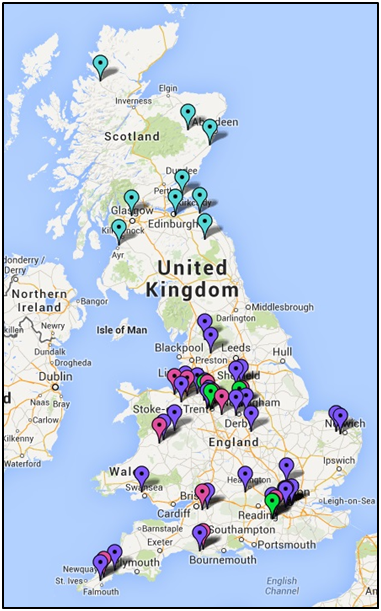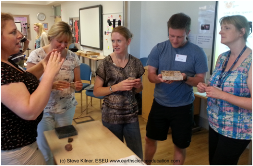Keele University’s Earth Science Education Unit (ESEU) has been going 15 years. They’ve trained 32,000 teachers. Chris King* goes back to the future.
Why is the Earth Science Education Unit (ESEU) needed? What do you do when research has shown that, although Earth science has been part of the science curriculum for several years, it is not being taught well? One response was to form the Earth Science Education Unit (ESEU) to help teachers improve by providing them with free and accessible professional development.
ESEU was formed in 1999 with funding from the trade association of the offshore oil industry, UKOOA (later Oil and Gas UK); infrastructure provided by Keele University and source materials from the Earth Science Teachers’ Association (ESTA). By supporting teachers to teach Earth science elements in the curriculum with confidence, the ESEU hopes to contribute to a larger goal: namely, to ‘…influence teachers and pupils, using Earth science as a context, to develop critical thinking in order to promote a better understanding of how the Earth works and how future generations could improve its management …’.
Research had showed that despite the National Science Curriculum containing a small but significant Earth science content, most teachers delivering this content were biology, chemistry or physics, specialists. Few had received any Earth science education as undergraduates or at school. When asked, they listed as their main sources of support for their Earth science teaching as science textbooks produced for pupils, and their own colleagues
1.
A later survey of all in-print science textbooks being used in schools in England and Wales, showed overall poor coverage of the National Curriculum’s Earth science content with, on average, one error per page of Earth science
2. A survey completed before the presentation of an ESEU workshop showed that most teachers had such major misconceptions about plate tectonics that they were very ill-equipped to teach this potentially difficult concept
3. The large majority of these teachers had never used Earth-science-specific teaching materials or attended professional development in Earth science teaching.
How does it work?
ESEU delivers interactive practically based workshops to whole school science departments or at initial teacher training institutions. These are delivered free, and can be offered in half day or ‘twilight’ sessions. An initial successful pilot in parts of northern England and the Midlands convinced the sponsors to support a national rollout.
 Map:ESEU facilitator network (purple = secondary, pink = primary, blue = Scottish, green = Earth physics facilitators
Map:ESEU facilitator network (purple = secondary, pink = primary, blue = Scottish, green = Earth physics facilitators
ESEU therefore appointed a network of facilitators across England and Wales (and later Scotland) to provide access to ESEU professional development teacher workshops across the country. The Central Team recruits and trains facilitators, to ensure consistent provision. They come from a range of backgrounds but all have strong geoscience and educational credentials. Once appointed, facilitators are supplied with a ‘kit’ of apparatus and materials for presenting the practical workshops.
ESEU’s suite of workshops targets the various Key Stages in England and Wales and the Curriculum for Excellence in Scotland. A crowded curriculum and constantly changing priorities in schools have made individual school delivery more difficult; but repeat visits mean that ESEU now visits more than half the secondary teacher training institutions in England and Wales every year.
Is ESEU effective?
Feedback from ESEU workshops has remained excellent throughout its 15-year history, with the mean score for ‘Effectiveness’, ‘Interest’, ‘Relevance’ and ‘Value’ (on a 1 – 5 Likert scale where 1 = high) being 1.62 for ESEU secondary delivery in England and Wales; feedback for Scotland and primary is similar.
Here are some comments:
‘There was a fantastic variety of new information over the whole workshop. The quality resources have given me more ideas of how to incorporate learning about Earth science in my future practice.’
‘Thoroughly enjoyed the session! I feel more interested in Earth Science now and see the potential of the subject in the classroom.’
‘PGCE tutors at Newman University, Birmingham had observed a noticeable improvement in Earth science teaching over the last few years when visiting schools and that was down to ESEU.&Isquo;
 Although a review of the extensive academic literature on the impact of professional development on teaching had commented: ‘There is universal condemnation in the research literature on professional development for the one-shot ‘INSET day’ as a method of bringing about any real change in teaching practice. Perhaps the only exception to this rule is the introduction of a very specific technical skill, such as the use of new piece of software.’5 Lydon and King4 concluded: ‘The evidence described above indicates that this exception should be extended to include the transmission of practical teaching ideas for the science classroom, where those teaching ideas are delivered by a well-trained provider, within a well-structured workshop which provides opportunities for exploration, practice, and peer feedback.’
Although a review of the extensive academic literature on the impact of professional development on teaching had commented: ‘There is universal condemnation in the research literature on professional development for the one-shot ‘INSET day’ as a method of bringing about any real change in teaching practice. Perhaps the only exception to this rule is the introduction of a very specific technical skill, such as the use of new piece of software.’5 Lydon and King4 concluded: ‘The evidence described above indicates that this exception should be extended to include the transmission of practical teaching ideas for the science classroom, where those teaching ideas are delivered by a well-trained provider, within a well-structured workshop which provides opportunities for exploration, practice, and peer feedback.’
How wide is ESEU’s impact?
Over its 15 years of operation, ESEU has provided professional development to more than 6000 secondary teachers and 16,000 trainees and more than 1000 primary teachers and 4000 trainees in England and Wales, together with more than 3000 teachers and 1000 trainees in Scotland and teachers and trainees in Northern Ireland as well.
Since ESEU data show that the average secondary science teacher in England reaches 393 pupils per year, this ‘multiplier’ effect indicates that ESEU’s work with practising teachers must have reached millions of pupils in England alone, while the total number of pupils impacted by the trainee teachers who have received ESEU workshops, over their teaching lifetimes, is incalculable – but must reach many millions.
Meanwhile, a recent review concluded: ‘It is arguable that the ESEU is an uncommon if not unique example of an industry–education partnership that has provided a national professional development programme, for teachers, focused on the mainstream curriculum.’
Where next?
ESEU continues to be funded by Oil and Gas UK, allowing ESEU to develop workshops for the new national curricula as they are introduced and maintain the provision of these workshops across the UK.
 However, changes to initial teacher training mean that subject specialists in geology are not being trained this year. This is at a time when geology teachers are retiring, A-level numbers are increasing, more than 40% of applicants to undergraduate geoscience degrees have geology A-level, and energy, environmental and extractive industries are reporting shortages of geoscientists.
However, changes to initial teacher training mean that subject specialists in geology are not being trained this year. This is at a time when geology teachers are retiring, A-level numbers are increasing, more than 40% of applicants to undergraduate geoscience degrees have geology A-level, and energy, environmental and extractive industries are reporting shortages of geoscientists.
ESEU’s response was to develop an accredited module, to be delivered through an intensive residential Summer School, for qualified teachers who have a geoscience related degree, successful completion of which would equip them to teach A-level geology (or Higher Geology in Scotland).
Oil &Gas UK’s core funding allowed materials to be developed, but additional industry bursaries covered residential accommodation costs, fieldwork and tuition costs. The first programme ran from 19 – 25 July with 10 teachers. Their feedback was exceptional, with mean evaluation scores (1 – excellent, 5- poor) of 1.6 for the teaching sessions and 1.4 for teaching skills developed and course organisation. ‘Best CPD in 20 years of teaching!’ commented one participant.
Acknowledgements
ESEU is most grateful to Oil and Gas UK for maintaining its core funding of ESEU activities for the past 15 years, together with Keele University and ESTA for continuing to provide facilities and support. ESEU is also most grateful to the oil industry bodies who have provided bursary funding for the Summer School to train new geology teachers.
References
- King, C. (2001) The response of teachers to new content in a National Science Curriculum: the case of the Earth-science component Science Education, 85, 636 – 664.
- King, C. (2010) An Analysis of Misconceptions in Science Textbooks: Earth science in England and Wales. International Journal of Science Education, 32: 5, 565 – 601.
- King, C. (2000) The Earth’s mantle is solid: teachers’ misconceptions about the Earth and plate tectonics.
- Lydon, S. & King, C. (2009) Can a single, short CPD workshop cause change in the classroom? Professional Development in Education, 35.1, 63-82.
- Adey, P. (2004) The Professional Development of Teachers: Practice and Theory (Boston, Kluwer Academic Publishers).